Landscape photography is both great fun, inspiring and hard work. It can be both physically and mentally demanding, carrying your gear to the ideal location, finding the right angle and of course the potentially agonising waits for the light to become just so. Today we are going to look at five essential items that will make your landscape photography just a little bit easier. Don't forget to take a look at our main landscape photography gear page for more ideas.
The Tripod
Of course a tripod is an essential part of the landscape photographer's kit bag – without it you cannot shoot slow shutter speeds or make careful and accurate compositions. One bugbear of tripods is their weight and overall clumsiness, especially if carrying them by foot to a far off location. The best option is to go for a lightweight carbon fibre tripod. Although not cheap, these tripods are very strong, often half the weight of aluminum or steel tripods and very steady.
Of course any tripod can struggle on a windswept hillside, so one little tip to steady you pod in difficult conditions is simply to hang your camera bag underneath it, giving it a few kilos of extra steadying weight. Don’t skimp on the tripod head either, make sure you have a quick and fluid quick release plate to ensure your can work quickly.

Don't leave home without a tripod by mikebaird, on Flickr
The App
You might think that a smartphone app is not an essential item. You might think that all the way until your start to use Photographers Ephemeris. This amazing little app will allow you to pinpoint your shooting location on a map and then will show you the path of the sun and the moon across that location for any given time. It shows the sunrise, sunset and even if nearby mountains will be obscuring the light in a certain direction. It is available for IOS and Android and is an invaluable addition to any landscape photographer’s kit.
A Spirit Level
Although your super lightweight and expensive carbon fibre tripod may have a built in spirit level, for the ultimate in perfectly horizontal horizons invest in a dedicated photographer’s spirit level. This little device plugs into your camera’s hotshoe and will allow you to check the position of your camera in all three planes – useful for a single landscape shot, vital if your are doing a multi image panoramic. With prices from a few dollars, there is no reason not to have one.

Small, cheap, essential by [puamelia], on Flickr
Square Filters
We all need filters at some stage, but for the landscape photographer in particular they are essential. The best laid plans of mice and men are often thwarted by mother nature, a bland sky or sunlight reflecting off of a lake, these are all little things nature can throw at us. Filters help us overcome these issues but round, screw in filters are cumbersome and difficult to screw on and off, when it's minus 10 and your hands are freezing. A square filter system is a must for landscape photography. Not only is it much easier to put the filters in or out, but filters like graduated neutral densities are much easier to position and of course stacking filters is a much more viable proposition with the reduced possibilities of vignetting. If you are on a budget, you can look at the Cokin P filter system but for the very best in quality, Lee Filters are regarded as the landscape photographer's perfect companion. Filters that would be considered vital are polarizers, neutral density and graduated neutral density.

Filters let you get shots like this by Jonathan Combe, on Flickr
The Remote
If you are shooting a small aperture then your shutter speed may be quite low. Even mounted on the sturdiest of tripods the act of touching the shutter button can induce camera shake and reduce image quality. The simple solution is to use the self timer on the camera but a more elegant and controllable option is to use a camera remote control. These devices can range from simple fire the shutter devices to all singing all dancing digital wonders that allow you complete control over exposure including setting a bulb time. Whilst the camera manufactures all sell remotes for their models, third party camera remotes are often cheaper whilst maintaining all the important functions.

Step away by Keith Williamson, on Flickr
So there you have it, five diverse and varied pieces of equipment each of which in its own way can make your next landscape shoot go much smoother.





2 Comments
Nice article. What’s your feeling about using ND grads vs bracketed shooting for HDR compositing?
I think that the more you can do to the image before it is digitized, the better. Every step you take in post production can degrade the image quality so if you can use the grads, but best to use good quality ones like Lee Filters